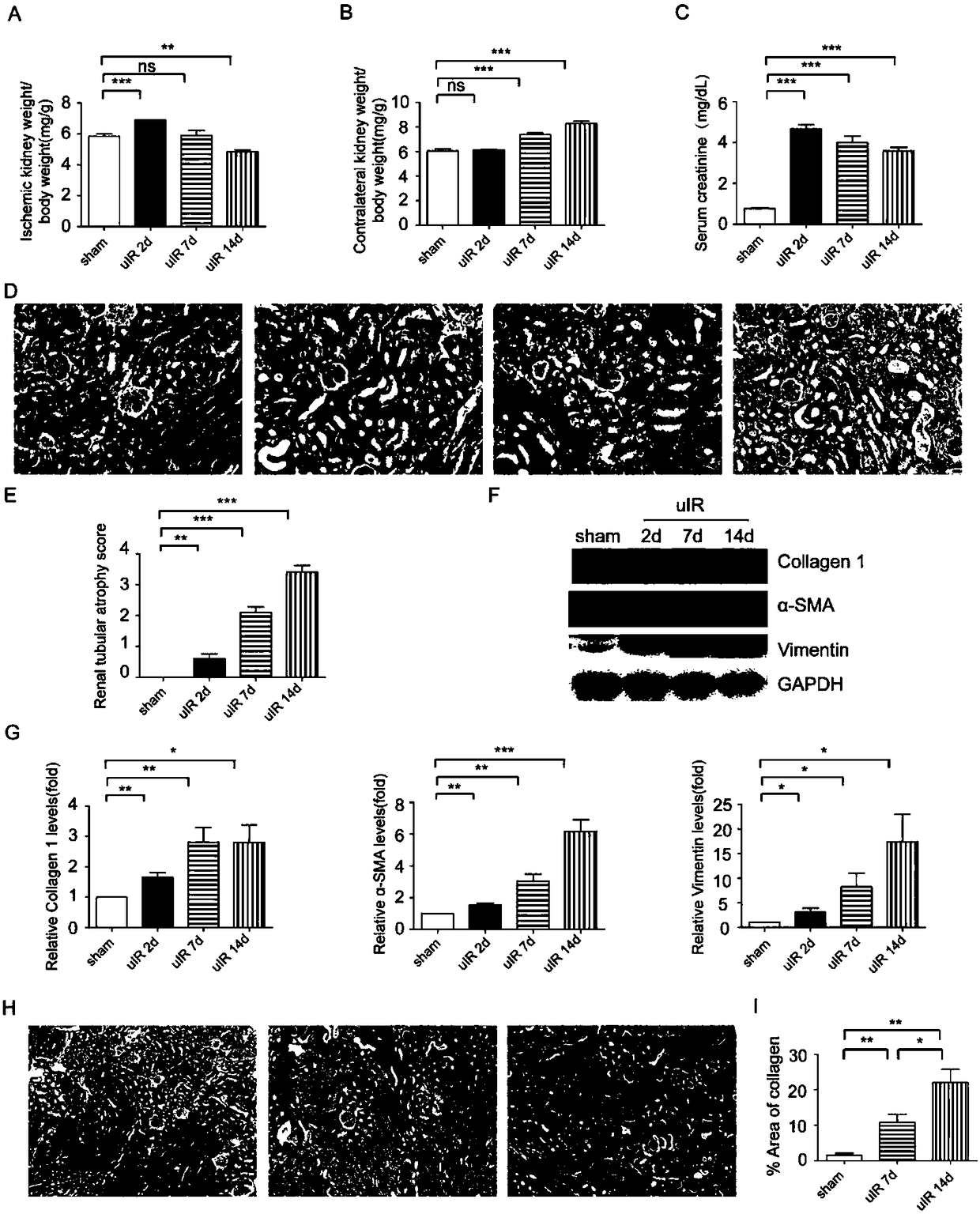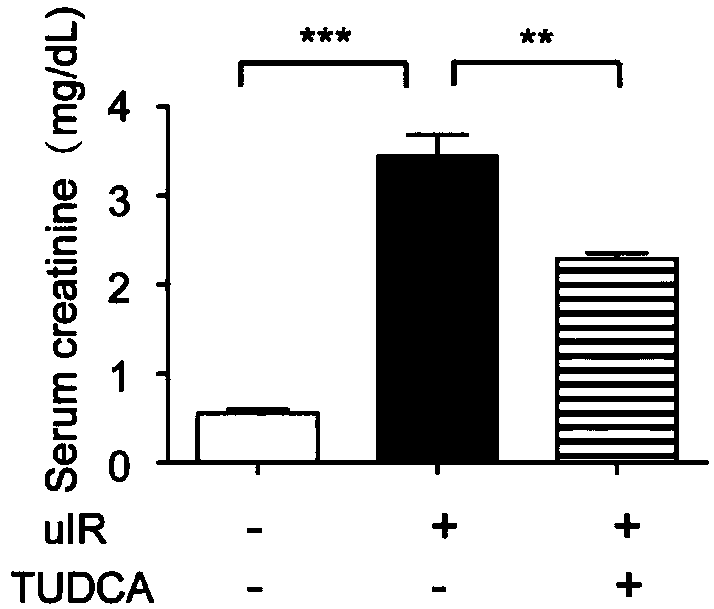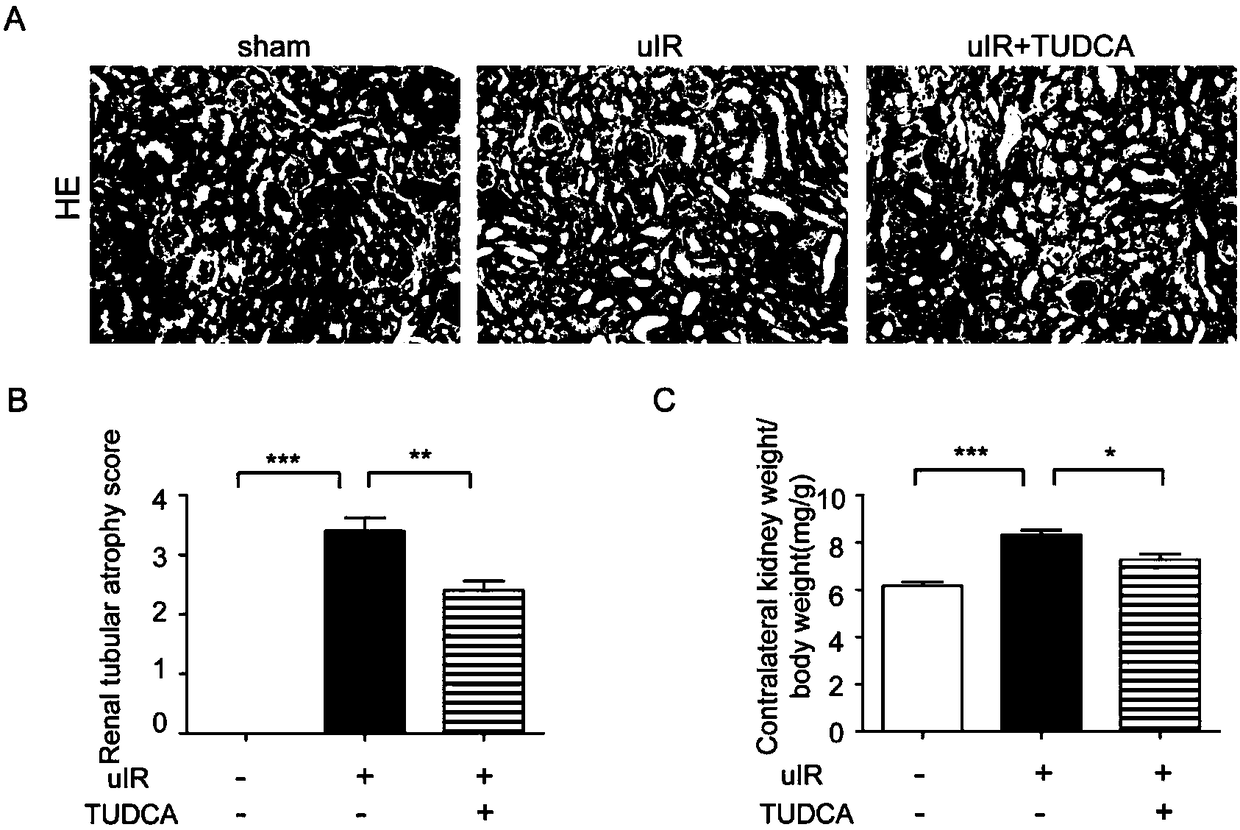Application of Tauroursodeoxycholic acid (TUDCA)
A technology for tauroursodeoxycholic acid and acute kidney injury, applied in the new use field of tauroursodeoxycholic acid
- Summary
- Abstract
- Description
- Claims
- Application Information
AI Technical Summary
Problems solved by technology
Method used
Image
Examples
Embodiment 1
[0041] C57BL / 6 mice (male, 8-10 weeks old) were subjected to sham surgery or 30 min unilateral ischemia of the left kidney followed by reperfusion. At 2 or 7 or 14 days, kidney tissues were collected for biochemical and histological analysis (A, B, D, E, F, G, H, I). Right nephrectomy was performed on day 1, 6 or 13 after uIR and mice were sacrificed 1 day later, at 2 or 7 or 14 days. Blood was collected to measure serum creatinine as an indication of left kidney function (C). (The purpose of detecting uIR 2d is to show that AKI has formed on day 2, so adding medicine on day 3 belongs to the treatment of AKI rather than the prevention or intervention of AKI formation. Both uIR 7d and uIR 14d represent CKD)
[0042] see test results figure 1 : Unilateral renal ischemia reperfusion (uIR) simulates the progression of kidney from acute kidney injury to chronic kidney disease in the human body.
[0043] (A) Ischemic side kidney weight / body weight (mg / g): When unilateral ischemia...
Embodiment 2
[0054] C57BL / 6 mice (male, 8-10 weeks old) were subjected to 30 min of unilateral ischemia of the left kidney followed by reperfusion. From the third day of unilateral renal ischemia reperfusion (uIR), intraperitoneal injection of TUDCA 250 mg / kg / day or the same amount of normal saline (NS) was given. Right nephrectomy was performed on day 13 after uIR, and mice were sacrificed 1 day later (ie, on day 14) and blood was collected to measure serum creatinine as an indication of left kidney function.
[0055] see test results figure 2 : In vivo experiments demonstrated that TUDCA improved renal dysfunction after ischemic acute kidney injury.
[0056] Serum creatinine (mg / dL): Compared with the control group (sham+NS), the concentration of serum creatinine in the operation group was significantly higher than that in the control group, ***P<0.001, indicating that uIR caused impaired renal function. At 14 days of uIR, compared with the NS injection group, the concentration of ser...
Embodiment 3
[0062] C57BL / 6 mice (male, 8-10 weeks old) were subjected to 30 min of unilateral ischemia of the left kidney followed by reperfusion. From the third day of uIR, intraperitoneal injection of TUDCA250mg / kg / day or the same amount of NS was given. Kidney tissue was collected on day 14.
[0063] see test results image 3 : In vivo experiments demonstrated that TUDCA improved tubular atrophy and compensatory hypertrophy of the contralateral kidney after acute kidney injury.
[0064] (A) HE staining of paraffin sections of renal tissue: Compared with the control group, at 14 days of uIR, some renal tubules fell off, the remaining renal tubules were structurally disordered, most of the renal tubules atrophied, and the renal tubules and interstitial space were obviously expanded Accompanied by a large number of necrotic fragments in the small lumen. When uIR was 14 days, there was a significant reduction in atrophic ducts in the TUDCA-injected group compared with the NS-injected gr...
PUM
 Login to View More
Login to View More Abstract
Description
Claims
Application Information
 Login to View More
Login to View More - R&D
- Intellectual Property
- Life Sciences
- Materials
- Tech Scout
- Unparalleled Data Quality
- Higher Quality Content
- 60% Fewer Hallucinations
Browse by: Latest US Patents, China's latest patents, Technical Efficacy Thesaurus, Application Domain, Technology Topic, Popular Technical Reports.
© 2025 PatSnap. All rights reserved.Legal|Privacy policy|Modern Slavery Act Transparency Statement|Sitemap|About US| Contact US: help@patsnap.com



